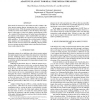Free Online Productivity Tools
i2Speak
i2Symbol
i2OCR
iTex2Img
iWeb2Print
iWeb2Shot
i2Type
iPdf2Split
iPdf2Merge
i2Bopomofo
i2Arabic
i2Style
i2Image
i2PDF
iLatex2Rtf
Sci2ools
ISCAS
2002
IEEE
2002
IEEE
Adaptive playout for real-time media streaming
When media is streamed over best-effort networks, a buffer at the client protects against playout interruptions due to variations in the data arrival rate. While the amount of protection offered grows with the size of the client’s buffer, so does the latency that is introduced. In this paper we show how adaptive media playout (AMP) - the variation of the playout speed of media frames depending on the condition of the channel - allows smaller buffer sizes and correspondingly smaller delays for a given level of protection against buffer underflow. We demonstrate this with the results of Markov chain analyses and with simulations. In addition, we consider AMP as a form of receiver-driven rate scalability, allowing clients access to streams encoded at higher source rates than their connections would ordinarily allow.
| Added | 15 Jul 2010 |
| Updated | 15 Jul 2010 |
| Type | Conference |
| Year | 2002 |
| Where | ISCAS |
| Authors | Mark Kalman, Eckehard G. Steinbach, Bernd Girod |
Comments (0)

